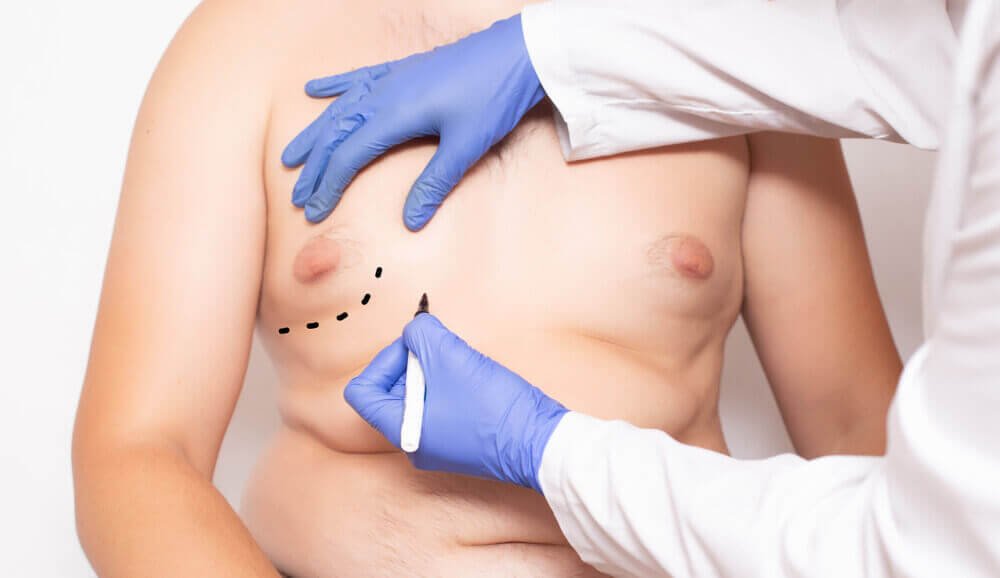Gynecomastia is a condition in which a man’s breast tissue enlarges or swells. Male estrogen levels that are too high or out of balance with testosterone levels are the most common cause.
Gynecomastia surgery is a procedure that decreases the size of a man’s breasts while both flattening and strengthening the chest contours. The weight of excess breast tissue will cause the breasts to sag and spread the areola in extreme cases of gynecomastia. The position and scale of the areola can be changed surgically in these situations, and excess skin can be reduced.
The surgical correction of overdeveloped or swollen breasts in men is known as gynecomastia surgery, also known as male breast reduction. Reduction mammoplasty is a form of plastic surgery used to treat gynecomastia.
Causes of Gynecomastia
Hormone Imbalance
An imbalance between the sex hormones testosterone and estrogen may induce gynecomastia. Breast tissue expands as a result of estrogen. Although all men develop certain estrogen, their testosterone levels are normally much higher, preventing the estrogen from allowing breast tissue to grow.
A change in hormone balance in the body may cause a man’s breasts to grow. The cause of this imbalance is often unknown.
Obesity
Gynecomastia is often caused by being extremely overweight (obese). This is because being overweight will cause estrogen levels to rise, causing breast tissue to expand. If you’re overweight, you’re more likely to get extra fat in your breasts, which may cause them to swell. Losing weight or will exercise can benefit some people, but it does not always improve their condition.
Puberty
Boys’ hormone levels fluctuate during puberty. Estrogen may allow the breast tissue to develop if testosterone levels decrease. Many young boys have breast enlargement to some degree. When boys grow older and their testosterone levels become more stable, gynecomastia normally goes away.
Older age
Men produce less testosterone as they age. Older men also have more body fat, which can lead to an increase in estrogen production. Excessive breast tissue development can result from these hormonal changes.
Procedure and Surgery of Gynecomastia
Gynecomastia treatment helps to maintain a natural male breast contour while also correcting deformities of the breast, nipple, and areola. Liposuction, excision, surgical tissue removal, or a mixture of the two are surgical alternatives. Since glandular breast tissue is denser than fatty tissue, liposuction is not recommended.
The choice of skin redundancy after surgery affects the surgical procedure chosen. Skin shrinkage is more common in younger patients than in older ones. The intra-areolar incision, or Webster incision, is the most frequent method, and it runs along the diameter of the pigmented half of the areola.
Your incision length will be decided by your anatomy. Skin resection (surgical removal of a portion of an organ or structure) and nipple relocation may be needed in cases of extreme gynecomastia.
The popularity of minimally invasive gynecomastia surgical procedures has grown. A very slight incision is made at the areolar edge in the “pull-through procedure.” The smaller incision is the main benefit of this treatment. This method is used on patients that have been carefully chosen.
The outcomes of gynecomastia correction have improved due to ultrasonic liposuction. There is less blood flow compromise, nipple distortion, and areola slough for liposuction-assisted breast reduction. Furthermore, compared to open surgical resection, this procedure has fewer postoperative complications.
Pectoral Implants
Pectoral augmentation is a surgical technique that can be used to give a man the chest definition he’s always desired. They have long been used to reconstruct the chest following cancer surgery in men, and they can also be used to add bulk to the chest.
The Procedure of Pectoral Implants
During your appointment, your surgeon can take measurements of your chest and go through the various sizes and shapes of implants available. Before the surgery, you will be given general anesthesia or extremely sedated.
Through the incision, special surgical instruments are implanted and used to build a pocket, or space, between the pectoralis major and minor muscles (chest muscles). The implant is implanted and located between the pectoralis muscles, based on measurements taken before surgery.
• After closing the incision, the process is repeated on the other side.
• A compression garment can be worn during the surgery to help reduce swelling and implant transfer.
Final words
Pectoral replacements are a reasonably simple procedure that has been carried out regularly for decades. Pectoral implants are used for several purposes, including reconstructive and gender-affirming surgeries.
If you’re in good shape and don’t have a history of keloid scarring, you have a good chance of getting a smooth pectoral implant operation. It will take about two weeks for you to recover, and you will need to see the doctor before you start working out.
Likely, you won’t be satisfied with the results of the surgery if you have unrealistic expectations of what this surgery will do or if you have muscle dysmorphia.
Before deciding on a cosmetic surgeon, be open and honest with your specialist about the look you want to achieve.

